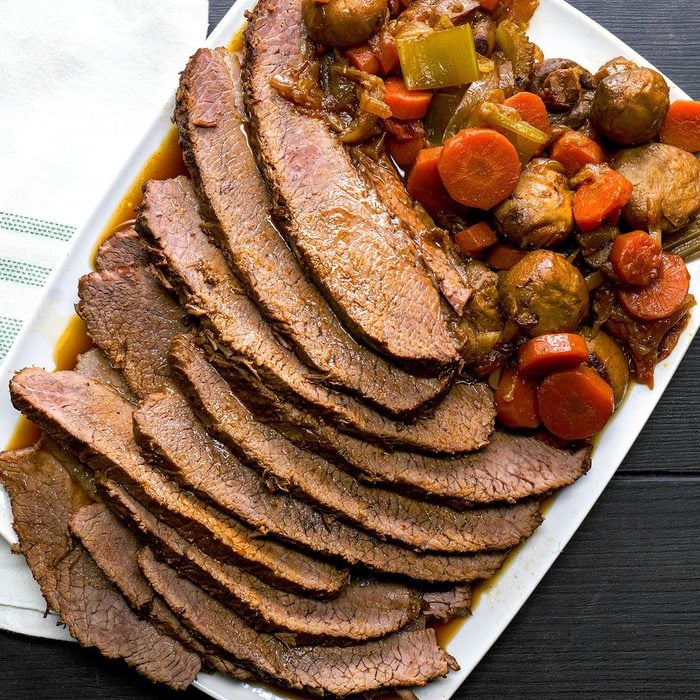Most of us are familiar with brisket in its smoked or cured forms: barbecue brisket, corned beef and pastrami. But Jewish brisket—a version featuring braised meat—can’t be beaten. The meat becomes mouthwateringly tender as it simmers on the stovetop, and the cooking liquid turns into a sauce that’s good enough to drink through a straw.
Jewish brisket has become a staple Jewish food and is enjoyed for holidays like Passover, Rosh Hashanah and Hanukkah. But that doesn’t mean you have to be Jewish or celebrating a holiday to enjoy braised brisket. It’s perfect for any dinner party or a Sunday supper. So pour a glass of kosher wine and learn how to make this delicious brisket.
How do you make brisket tender?
Brisket has a reputation for being hard to cook. It comes from a well-worked muscle in the cow and contains a lot of connective tissue. If you cook it too quickly (or at a too-high temperature), the meat will seize up and never become tender. The good news: With a little practice, brisket is an easy cut of meat to master.
A tender brisket starts at the grocery store. You want to choose a brisket with good marbling. Marbling refers to the long streaks of white fat within the lean sections of the meat. The more marbling, the more flavorful and tender the brisket. This intramuscular fat melts as the brisket cooks, keeping the meat juicy. Prime grades of beef have more marbling, but you can always ask your butcher for advice if you’re unsure.
From there, the secret to a tender brisket is all about time and temperature. Take your time, and use low heat. Don’t try to rush it by boiling the brisket. And, if you can, make the brisket a day in advance. Cooling it whole in the cooking liquid is the best way to keep the brisket from drying out.
Jewish Brisket Ingredients
- Beef brisket: We like the lean flat cut for sliced brisket preparations. It still has plenty of intramuscular fat to keep the meat juicy, and it looks more appealing than the fatty point cut. As a bonus, it’s easier to slice, so it’s a win-win.
- Vegetables: The onions, carrots, celery and mushrooms add flavor to the brisket. The veggies also become super flavorful as the fat drips onto them from the cooking brisket. They’re a perfect side dish.
- Worcestershire sauce: Not all Worcestershire sauce is kosher, so check the ingredients label before leaving the store.
- Tomato sauce: Tomatoes add savory flavor and acidity to the cooking liquid, which helps to tenderize the meat. You could use ketchup instead if you want to introduce a sweet element.
- Prepared horseradish: Horseradish adds a little zip to the sauce. Use up the rest of the jar with these horseradish recipes.
Directions
Step 1: Brown the brisket
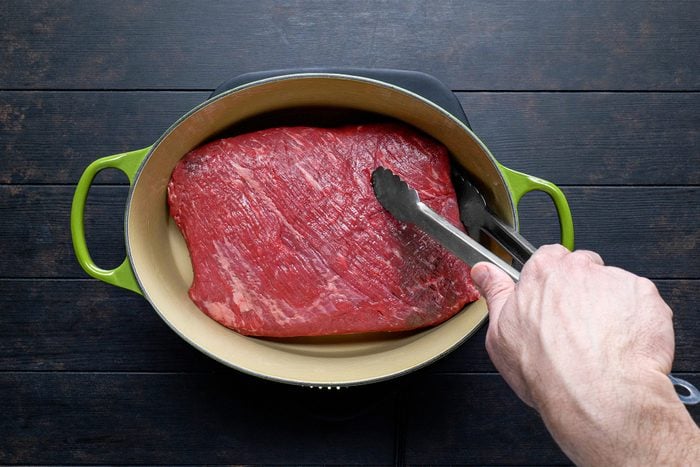
In a Dutch oven, heat the oil over medium heat. Brown the brisket on both sides. Remove the meat from the pan.
Editor’s Tip: Flipping a 5-pound hunk of meat can be intimidating, but it’s worth it. Browning the meat on both sides adds a caramelized flavor to the brisket and sauce. Cook the brisket long enough on each side to get a deep brown crust, about five to eight minutes per side.
Step 2: Cook the vegetables
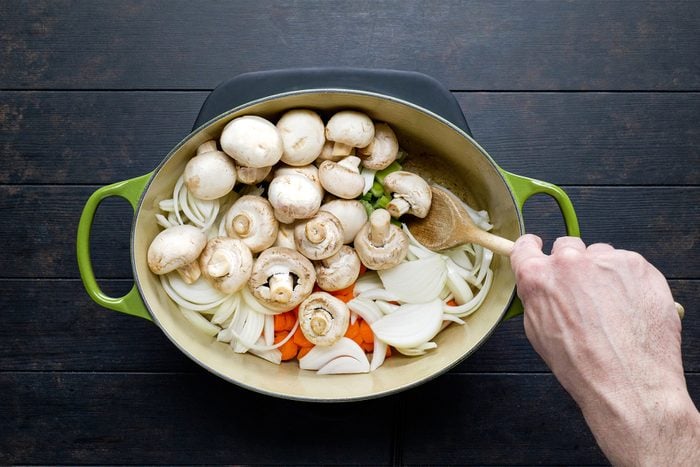
Add the celery, carrots, onions and mushrooms to the same pan. Cook and stir for four to six minutes or until crisp-tender.
Step 3: Add the liquids
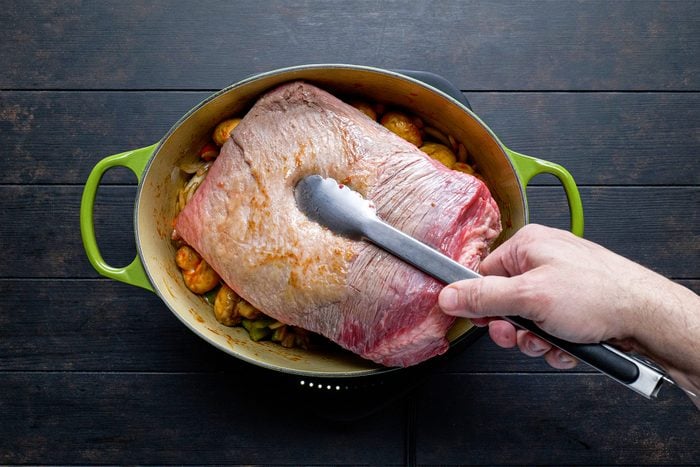
Stir in the water, tomato sauce, Worcestershire sauce and prepared horseradish. Return the brisket to the pan, fat side up.
Editor’s Tip: Fat side up is the way to go when cooking brisket. It ensures all the juices from the fat will seep down and tenderize the meat. These juices also drip down to flavor the vegetables and cooking liquid.
Step 4: Simmer for hours
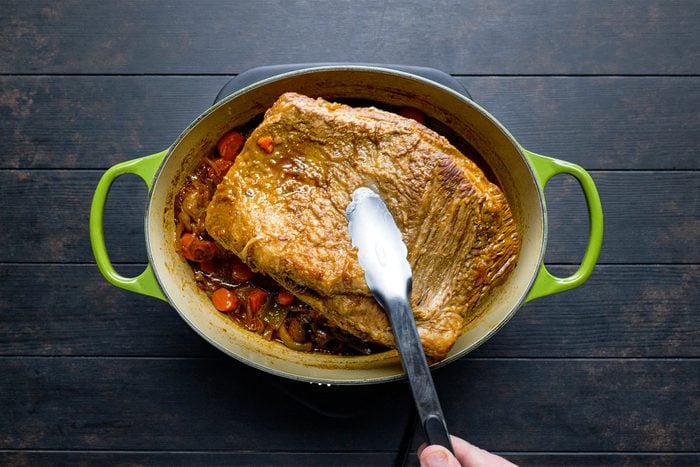
Bring the mixture to a boil. Then, reduce the heat. Simmer, covered, for 2 hours and 30 minutes to 3 hours or until the meat is tender.
Editor’s Tip: The liquid should simmer but not boil. Boiling will cook the meat too quickly, turning it tough instead of tender. If you’re having trouble finding the right setting and don’t want to fiddle with the stovetop knobs, transfer the brisket to a 275°F oven. The oven will maintain a steady simmer.
Step 5: Prepare the sauce
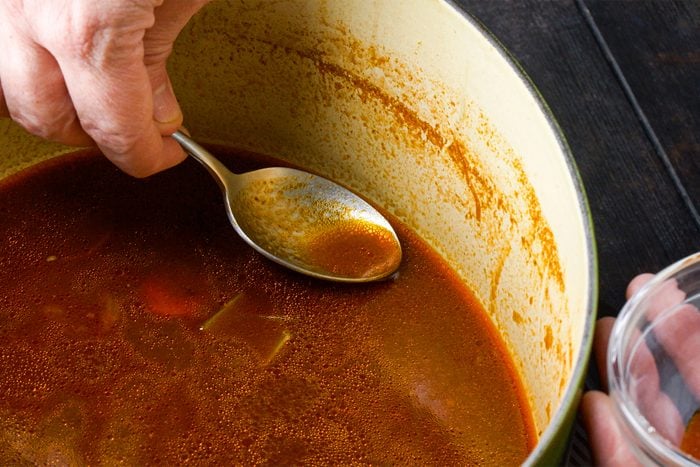
Remove the brisket and vegetables from the pan. Set aside, and keep warm. Skim the fat from the pan juices. If desired, thicken the juices.
Step 6: Slice
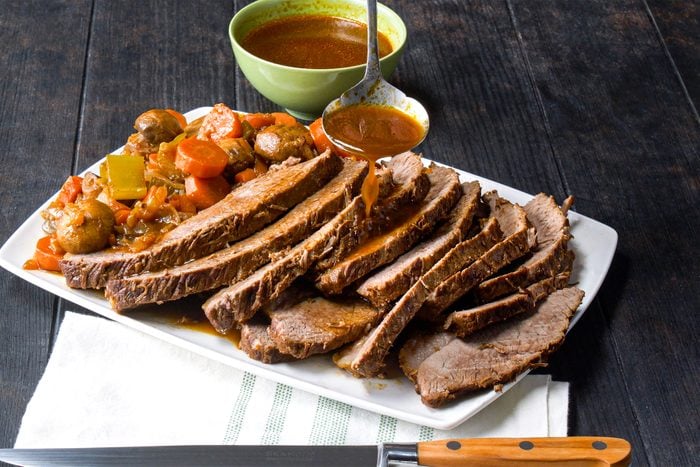
Cut the brisket diagonally across the grain into thin slices. Serve with the vegetables and pan juices.
Editor’s Tip: Before you cut into the meat, let the brisket rest for about 10 minutes. This will allow the juices to redistribute within the meat. Then, cut against the grain so the meat is easier to chew, and thus more tender.
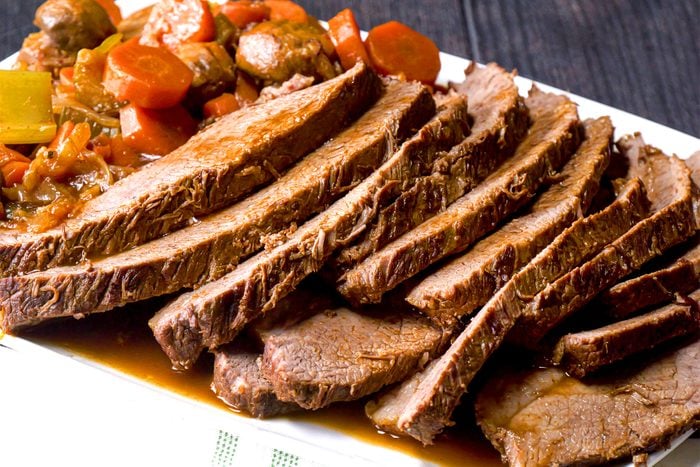
Recipe Variations
- Change the braising liquid: Customize the cooking liquid to give your brisket a signature flavor. Use red wine, orange juice or soda like cola. Add a packet of onion soup to the mix. Or go the Marvelous Mrs. Maisel brisket route and use beer, cranberry sauce and chili sauce. If you’re preparing this recipe as a Passover brisket, just make sure all the ingredients are kosher for Passover.
- Add herbs and spices: Include bay leaves, thyme and rosemary to add an herby aromatic finish to our Jewish brisket. You can also add spices like chili powder, paprika or cayenne pepper to add heat.
Can you make Jewish brisket ahead of time?
Brisket is a great make-ahead dish. In fact, this brisket gets better over time! Cooling it down whole allows the juices to stay inside the meat as the brisket rests overnight. The flavors in the sauce will also continue to develop in the refrigerator. Finally (if you need more convincing), cold brisket is easier to slice.
Cook the brisket a day ahead of your event. Leave the brisket and vegetables in the Dutch oven, and let the dish cool slightly. Cover the pan, and refrigerate overnight.
When you’re ready to reheat the brisket, remove the pan from the refrigerator. Let it sit on the counter while you preheat the oven to 250°. Use a spoon to scrape away the fat on the surface. Remove the brisket to a cutting board, and slice it into thin slices against the grain. Return the slices to the pan. Cover the pan tightly, and heat the brisket until it’s warmed through, about 60 to 90 minutes.
How to Store Jewish Brisket
Store the sliced brisket with the sauce in an airtight container. The sauce will keep the sliced brisket from drying out. Leftover brisket is good for up to four days in the refrigerator. You can also freeze the sliced brisket and sauce in a freezer-safe container, where it’s good for up to three months. Reheat brisket as directed above.
Jewish Brisket Tips
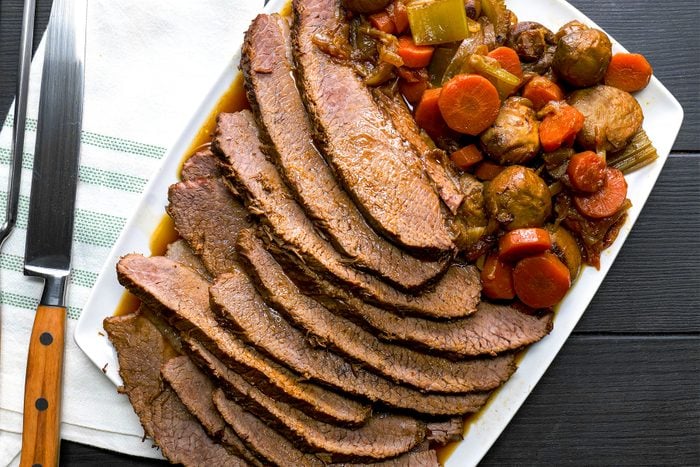
What is traditionally served with Jewish brisket?
Brisket pairs well with most Passover side dishes and Hanukkah recipes. You can’t go wrong with tzimmes, potato latkes, charoset or potato kugel. Don’t forget to start the meal with matzo ball soup! If you’re serving a Jewish holiday brisket, be sure to use kosher ingredients (like kosher Worcestershire sauce) and avoid side dishes with dairy.
How much brisket do you need per person?
In general, plan for 1/2 pound of uncooked brisket per person. Some eaters may eat more and some may eat less. It’s never a bad idea to add an extra pound or two, just in case your guests come extra hungry. Plus, the leftovers taste great and they freeze well.
How do you thicken brisket sauce?
Our brisket sauce has an au jus consistency, but you can thicken it to become more gravy-like using kosher-friendly potato starch. Place the strained, skimmed juices in a small saucepan over medium-high heat. Use 1 tablespoon of potato starch per cup of sauce. Mix the starch with 1/4 cup water to create a slurry. Simmer the slurry in the juices for two to three minutes, until sufficiently thickened.
If you don’t want to use potato starch, use another method to thicken the sauce. You can simmer the strained cooking liquid until it’s reduced by half. Or, puree some of the cooked onions, carrots, celery and mushrooms. Whisk the pureed vegetables back into the sauce before serving.




















